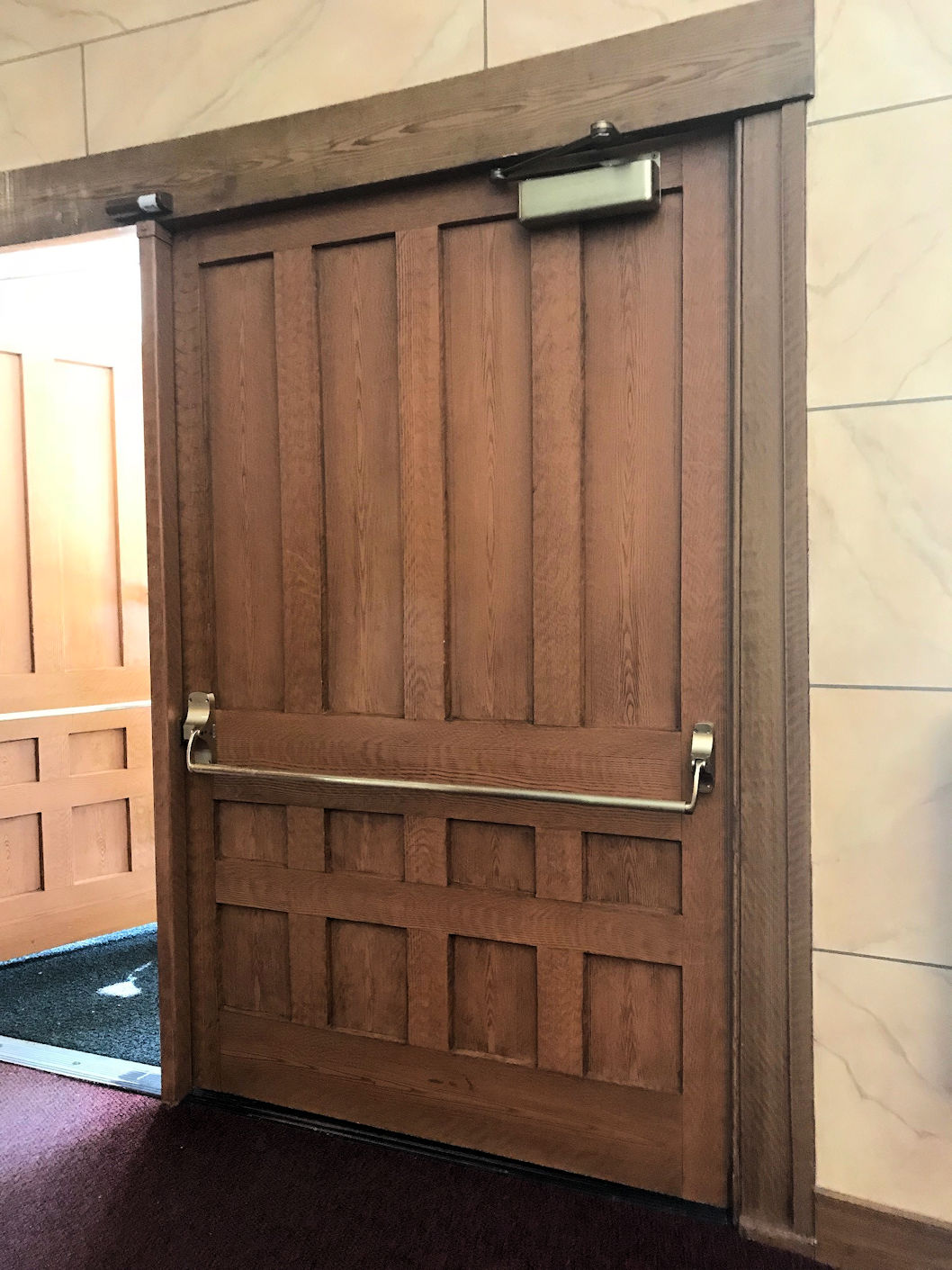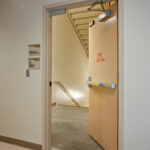In Mark Kuhn’s next post, he writes about a problem many hardware specifiers have faced…a conflict between door width and the code requirements for panic hardware.
~~~
 I’ve run across an interesting situation recently that I feel requires some focus. One of the code changes made in the 2021 edition of the International Building Code (IBC) was related to the maximum width of doors in a means of egress. Prior to the 2021 edition, the IBC stated that the maximum width of a swinging door leaf was 48 inches (IBC Section 1010.1.1 “Size of Doors”). So, if you had a door in an egress path you were limited to a width of 48 inches for a single door or 96 inches for a pair of doors, but in 2021 the IBC deleted the reference to a “maximum width.” This had been removed from NFPA 101 – Life Safety Code several editions prior.
I’ve run across an interesting situation recently that I feel requires some focus. One of the code changes made in the 2021 edition of the International Building Code (IBC) was related to the maximum width of doors in a means of egress. Prior to the 2021 edition, the IBC stated that the maximum width of a swinging door leaf was 48 inches (IBC Section 1010.1.1 “Size of Doors”). So, if you had a door in an egress path you were limited to a width of 48 inches for a single door or 96 inches for a pair of doors, but in 2021 the IBC deleted the reference to a “maximum width.” This had been removed from NFPA 101 – Life Safety Code several editions prior.
On the surface this would seem insignificant. You might ask, what does it matter, if I can now use a door leaf wider than 48 inches in a means of egress? I should also mention that this would be a custom door, because any door leaf over 4 feet wide is custom (or at least it was prior to IBC-2021 ).
Well in my “day job” as an architectural consultant and specification writer I am now seeing door leaf widths greater than 48 inches being used more frequently. I recently wrote a specification for a church where a 10-foot-wide pair had been requested for the doors serving the sanctuary, which had an occupant load of more than 2,000 people. The reason for the wide doors was because of a large piece of equipment that the doors had to accommodate.
Now we have a couple of things going on…we have an egress door serving an assembly occupancy with a calculated occupant load of more than 50 people, and we have a door leaf wider than 48 inches. Does everyone see where I’m going with this?
According to IBC-2021, Section 1010.2.9, if I have an assembly occupancy with an occupant load greater than 50 people, then I am required to have panic hardware or fire exit hardware on any doors serving this area that are equipped with a lock or latch. And according to IBC-2021, Section 1010.2.9.3 (Item 3), the actuating portion of that panic hardware must measure at least half the width of the door leaf.
Now back before we (and by “we” I mean EVERY panic hardware manufacturer) introduced the touchpad style exit device, this would not be a problem. This was because the old crossbar style panics typically came with what was essentially a long pipe that could be cut to whatever length you needed. But most ANSI/BHMA Grade 1, touchpad style exit devices do not have an actuating portion that would be code compliant for a door leaf greater than 48 inches.
I’d love to know if you’re seeing wider doors more frequently on current projects, and what you think about this.
WWYD?
Thanks to Ann Timme of Allegion for the photo of a wide door with a crossbar panic.
You need to login or register to bookmark/favorite this content.










If main door, just do not use panic hardware?
So what is the widest actuating portion von during makes?
Yes Sir, that is a code compliant option for the main entry doors. Unfortunately this was not the main entry. And currently Von Duprin’s widest touchpad is 24″.
-Mark
Well. My second biggest gripe
And cannot see the 2024 ibc
Main Entrance is not defined….
So you can have more than one
Think of the old McDonald’s set up, park on either side of the building? And you can enter on either side.
Guess a design and tested panic hardware is in the works, for wider doors
Good article
Go with 10/0×7/0 opening
With two 48″ leafs with a removable 2/0×7/0 removable panel/mullion in the middle.
2 each von duprin 99-Rim exits.
Any door wider than 4/0 is a waste of door.
Your asking for all kinds of troubles after 4/0 wide.
3/0 wide minimum, 4/0 wide maximum and all is good.
This also goes for pedestrian gates, And always swing outward. (Push to exit).
They don’t call it Hardware because it’s easy.
All good comments.
-Mark
The following hardware can be used based on this 10-0 x 12-0 listing
https://bpdirectory.intertek.com/pages/Report.aspx?ReportName=Listing&Type=Single&SpecID=15946
Hollow Metal Type (18, 16, 14 gauge) (Steel-Stiffened), Swinging Flush Design Fire Door for use with Pressed
Steel (Welded-Up) (16, 14, 12 gauge) Door Frame for installation in 90 minute locations (per HMMA 861-00).
Limitations
Cylindrical or mortise latch with minimum throw of 3/4″; single swing doors exceeding 10′ in height require
an auxiliary fire latch, engaging into the frame head rabbet preparation
Pairs require minimum 3-point standard latching.
Active leaf of pairs exceeding 8’ width – Head of active leaf at lock stile prepared for listed, mortise
type, auxiliary fire latch, engaging into frame head rabbet preparation
Inactive leaf of pairs – Listed flush or surface bolts, automatic, manual, or self-latching types, 3/4”
minimum throw, listed for use on 4’ x 10’ x 1-1/2 hour minimum hollow metal fire doors.
Bolts to 60” maximum length may be provided
Non-temperature rise rated doors (TRR exceeding 650°F at 20 minutes), provided with 2 pcf maximum
density batt-type insulation in the voids between stiffeners
Maximum temperature rise rating for TRR configuration – 450°F at 30 minutes
Astragal required for TRR pairs exceeding 8’ in width or 10’ in height
Maximum Sizes of Openings
Single 5’0″ wide x 12’0″ high
Standard Pair 10’0″ wide x 12’0″ high
Double Egress Not allowed
Door leaf thickness: 1-3/4″ to 2″
This addresses the fire label permitted use. Mark was discussing the fact that panic and exit bars made by most common manufacturers are not made with touchpad portions longer than 24″, limiting the width of the door to 48″ due to the “actuating portion must span at least half the door” (the part that gets pressed).
You might be able to get a special engineering request done to get longer bars, but I don’t know of a regular manufacturer that has these options off the shelf.
Recently i was working on an entertainment city project in the Middle East which was based on IBC and some of the egress doors were 1250mm wide and i had no other options left to approve the 4′ wide Exit devices on them.
I approved with my notes recommending to use the Cross Bar Exit Devices which can meet the code requirements of touchpad length to be half the door width. But the designer did not want to change the Touch pad exit device to cross bar as Touch pad exit devices were used thru out the facility. then i ask them to get the AHJ’s approval and it was approved to go with the Touch pad Exit device of 4′.
Lori what is your advise on such situation.
Hi Salim –
I think our responsibility is to notify the architect of the issue, but if the AHJ approves it, that would be the end of the conversation for me.
– Lori
If you had a cross bar panic on a door 60″ wide, you will really need to push the door closest to the leading (lock stile) edge if you want to get it open. Pushing a door that wide at the center of the door will make it feel like an STC door on cam lift hinges-way too difficult, It might be best to have a touchpad exit device mounted closer to the lock stile. that may draw people towards it, to allow for an easier door to open. And there’s no point in discussing the opening force issues this would create.
Hey Robby –
How about a crossbar device that is half the width of the door but not the full width (as long as it’s not spanning a full glass light)?
– Lori